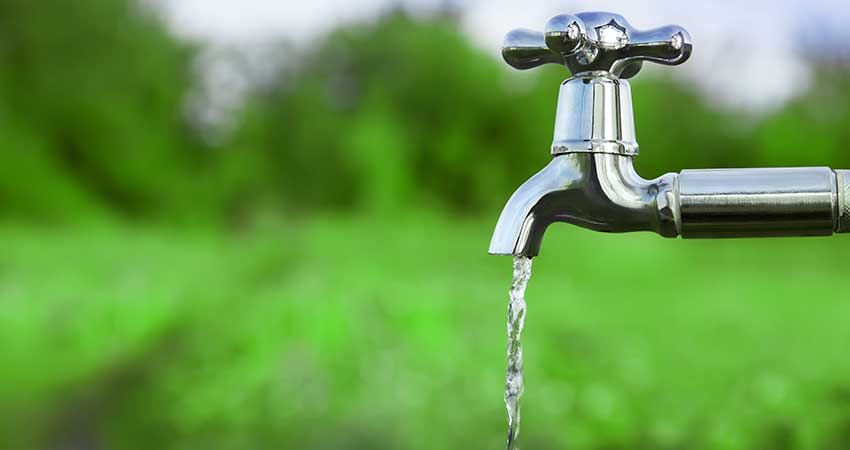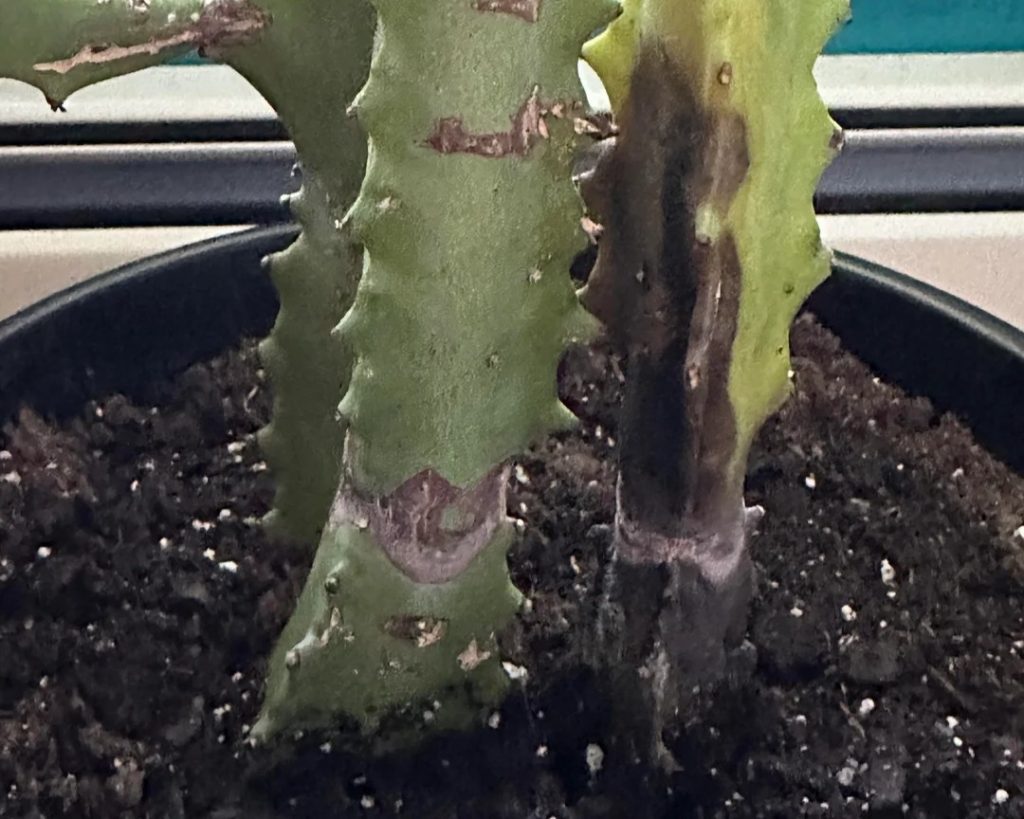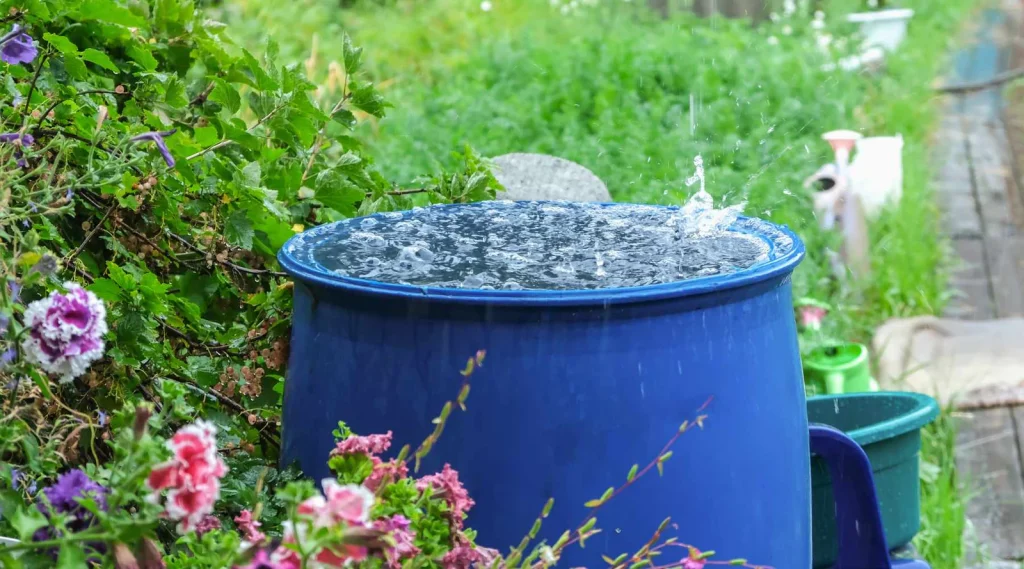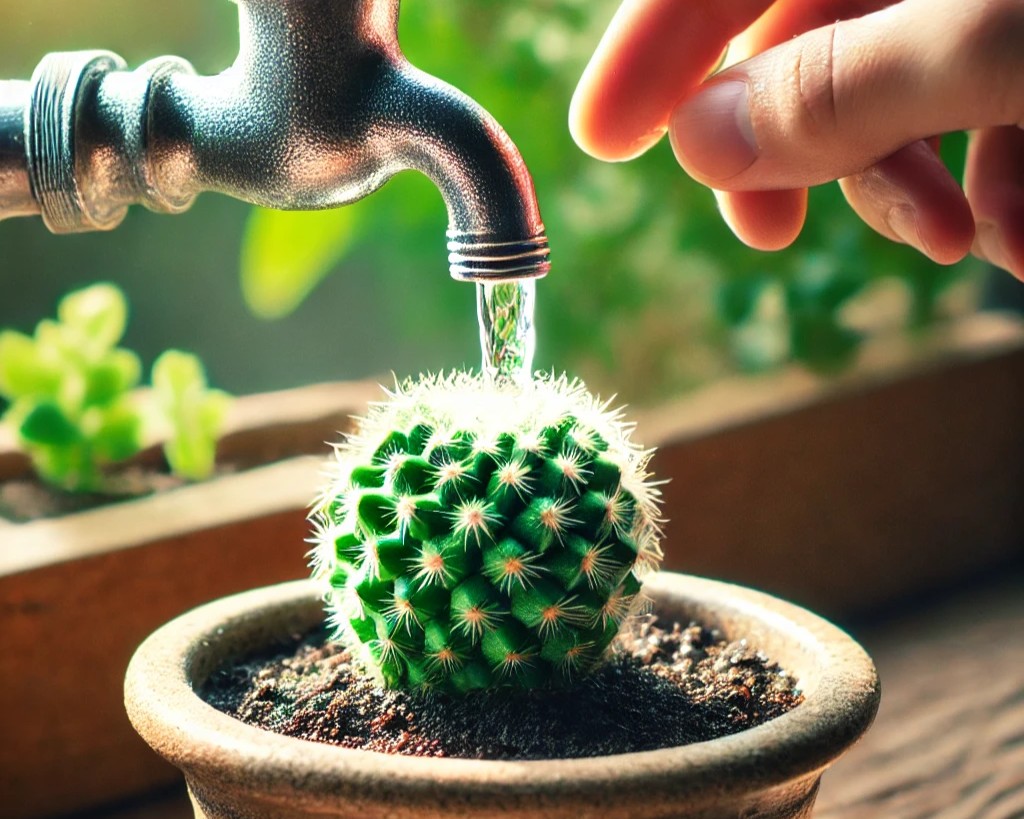If you own a cactus, you’ve probably wondered: Can I water my cactus with tap water? It seems like a simple question, but the answer isn’t as straightforward as you might think. While tap water won’t instantly kill your cactus, it can cause long-term issues if it contains too many chemicals or minerals.
Cacti are tough, low-maintenance plants, but they’re also picky about what goes into their soil. Tap water often contains chlorine, fluoride, and mineral deposits that may slowly build up in the soil, affecting your cactus’s health. Over time, you might notice white crust forming on the soil, slowed growth, or even root damage—all signs that your plant isn’t happy with the water it’s getting.
But don’t worry! You don’t need to rush out and buy fancy bottled water for your cactus. In this article, we’ll break down what’s actually in tap water, how it affects cacti, and simple ways to make it safer—all while keeping things beginner-friendly and practical. Whether you’re a new plant parent or a seasoned cactus lover, you’ll get clear, expert-backed advice to keep your cactus thriving. Let’s dive in!
Understanding Your Tap Water: What’s in It?
Before you pour tap water into your cactus pot, let’s take a closer look at what’s actually in it. Many people assume that if tap water is safe for drinking, it must be fine for plants too—but that’s not always the case. Unlike rainwater or distilled water, tap water often contains added chemicals and minerals that can affect your cactus over time.

Chlorine and Chloramine – Are They Harmful?
Most municipal water supplies contain chlorine or chloramine, chemicals used to kill bacteria and make water safe for drinking. While these chemicals won’t immediately harm your cactus, they can build up in the soil over time, potentially affecting root health. Some cacti may show signs of stress, like slower growth or minor discoloration, especially if they’re sensitive species.
The good news? Chlorine evaporates naturally if you leave tap water sitting out for 24 hours—a simple trick many plant owners use. However, chloramine doesn’t evaporate as easily, so if your water contains this, you may need a filter to remove it.
Fluoride – A Hidden Threat?
Fluoride is another additive found in tap water, mainly to promote dental health. While it’s great for teeth, it’s not ideal for cacti. Some plants, particularly those with thin, delicate roots, may react negatively to fluoride, leading to leaf tip burn or slow root development. Since cacti store water in their tissues, fluoride exposure over time may cause subtle stress that’s hard to notice at first.
Hard Water – The Mineral Buildup Problem
If you live in an area with hard water (water with high levels of calcium, magnesium, or lime), you might notice white crust forming on the soil surface or the edges of your pot. This is caused by mineral deposits, which can alter the soil composition and make it harder for your cactus to absorb nutrients properly.
Hard water can also raise the pH level of your soil, making it more alkaline than cacti prefer. Most cacti thrive in slightly acidic to neutral soil (pH 5.5–7), so if your tap water consistently raises the pH, your plant might struggle to take in essential nutrients.
pH Levels – Does It Really Matter?
Yes, it does! The pH level of your water affects how well your cactus absorbs nutrients. Tap water can sometimes be too alkaline, especially in areas with hard water. If your soil pH gets too high over time, you may start noticing nutrient deficiencies, even if you’re fertilizing regularly.
Pro tip: If you suspect your tap water is too alkaline, you can test it using an inexpensive pH meter or test strips. If needed, you can adjust it by adding a few drops of white vinegar or using rainwater occasionally to balance things out.
Is Tap Water Bad for Your Cactus?
Not necessarily! Many cacti can adapt to tap water, but it depends on what’s in your local supply. The key is to understand your water quality and take simple steps to minimize any risks. In the next section, we’ll discuss the possible effects of tap water on cacti and how to recognize if your plant is struggling with it.
Ready to dive deeper? Let’s go!
Effects of Tap Water on Cacti
Now that you know what’s in tap water, let’s talk about how it actually affects your cactus. While your plant won’t immediately suffer after a few rounds of tap water, long-term exposure can cause noticeable issues. The key is to recognize the warning signs early so you can adjust before any serious damage occurs.
Short-Term Effects – What Happens Right Away?
If your tap water is relatively clean, your cactus might not show immediate distress. However, in areas with high chlorine, fluoride, or mineral content, you might notice:
- Slight yellowing or browning at the base of the plant.
- Water spots on the cactus skin caused by mineral residue drying on the surface.
- Sluggish water absorption, meaning the soil stays damp longer than expected.
These signs aren’t necessarily alarming at first, but they indicate that something may be off.
Long-Term Effects – The Hidden Damage
Over time, consistent use of tap water can lead to deeper problems that aren’t always obvious right away. Some of the biggest concerns include:
- Mineral Buildup in the Soil
- Hard water contains minerals like calcium and magnesium, which don’t just disappear after watering. Instead, they accumulate in the soil, making it harder for roots to absorb essential nutrients.
- A white, chalky crust may form on the soil surface or around the edges of the pot, indicating excessive mineral deposits.
- Root Stress and Nutrient Deficiency
- When mineral buildup alters the soil’s structure and pH, your cactus may struggle to take in water and nutrients properly.
- This can lead to slow growth, weak roots, and dull-looking skin.
- If the issue persists, it could even cause root rot—not from overwatering, but because the roots are too stressed to function properly.
- Fluoride Sensitivity
- Some cacti, especially those with thin or fibrous roots, can be more sensitive to fluoride.
- Long-term exposure may cause slight browning or tip burn, which often goes unnoticed until the damage becomes more severe.
How to Tell If Tap Water Is Affecting Your Cactus
If you suspect that your tap water might be harming your plant, look out for these signs:
- White crust on soil or pot edges – A clear sign of excess minerals.
- Yellowing or browning at the base – Possible root stress or chemical buildup.
- Slowed growth despite good care – The plant isn’t absorbing nutrients properly.
- Soil staying damp longer than usual – Indicates mineral interference with drainage.
If you’re seeing one or more of these signs, don’t worry—there are simple ways to fix the problem. In the next section, we’ll cover how to make tap water safer for your cactus so you can keep your plant thriving without constantly worrying about water quality.
Let’s move on to the solutions.

How to Make Tap Water Safer for Your Cactus
If you’ve noticed signs that tap water might be affecting your cactus, don’t worry—you don’t have to switch to expensive bottled water or collect rainwater immediately. There are simple and effective ways to make tap water safer while keeping your cactus healthy.
1. Let the Water Sit Before Using
One of the easiest ways to improve tap water quality is by letting it sit in an open container for 24 to 48 hours before watering. This allows:
- Chlorine to evaporate naturally, reducing the risk of chemical stress on your cactus.
- Fluoride levels to decrease slightly, though not as effectively as chlorine.
- Water temperature to adjust to room level, preventing shock to the roots.
Make sure to use a wide-mouthed container for better evaporation, and keep it in a well-ventilated area.
2. Use a Water Filter
If you live in an area with hard water or high chemical content, a basic water filter can make a huge difference. A simple carbon-based filter (like those found in pitcher filters) can:
- Remove chlorine, fluoride, and some minerals.
- Reduce heavy metals that might interfere with nutrient absorption.
- Provide more neutral, plant-friendly water.
For a long-term solution, consider installing a reverse osmosis (RO) system, which removes nearly all contaminants, leaving behind pure water that’s safe for your cactus.
3. Dilute Tap Water with Distilled or Rainwater
If you can’t completely avoid tap water, another option is to mix it with distilled or rainwater. This helps balance out the mineral content and reduces harmful effects over time. A good ratio is:
- 50% tap water + 50% distilled water for moderate water quality issues.
- 25% tap water + 75% rainwater if you live in an area with very hard water.
Rainwater is an excellent choice because it’s naturally soft and free from added chemicals. Just make sure to collect it in a clean container to avoid contamination.
4. Check and Adjust the pH Level
Cacti prefer water with a slightly acidic to neutral pH level, ideally between 6.0 and 7.0. Many tap water sources tend to be alkaline (above 7.5), which can cause nutrient imbalances.
To test your water’s pH:
- Use a simple pH test kit (available at gardening stores).
- If the water is too alkaline, add a few drops of white vinegar or a pinch of citric acid to lower the pH.
- If the water is too acidic, mix in a small amount of baking soda.
Maintaining the right pH ensures your cactus absorbs nutrients properly without stress.
5. Flush the Soil Occasionally
Even if you’re using tap water, you can prevent mineral buildup by flushing the soil every few months. Here’s how:
- Water the cactus deeply with distilled or rainwater until excess water drains out of the bottom.
- This process helps wash away accumulated minerals and salts from tap water.
- Let the soil dry out completely before watering again.
Flushing the soil mimics natural rainfall, giving your cactus a fresh start and keeping its roots healthy.
Final Thoughts
You don’t have to avoid tap water completely, but being mindful of its quality can help your cactus thrive. Simple steps like letting water sit, using filters, or adjusting the pH can make a big difference. By taking these precautions, you’ll create the perfect environment for your cactus to grow strong and healthy—without worrying about hidden damage from tap water.
Next, let’s explore alternative water sources and whether they might be a better fit for your cactus care routine.
Alternative Water Sources for Your Cactus – Are They Better Than Tap Water?
If tap water isn’t ideal for your cactus, what other options do you have? Let’s explore some alternative water sources and see if they’re a better fit.
1. Rainwater – The Best Natural Option
Rainwater is one of the best choices for watering cacti because it’s naturally soft, free from chlorine, fluoride, and heavy minerals. It’s also slightly acidic, which helps cacti absorb nutrients more efficiently.

Pros:
✔️ Free from harmful chemicals and salts.
✔️ Slightly acidic, which benefits soil health.
✔️ Soft water that won’t cause mineral buildup.
Cons:
❌ Availability depends on weather and season.
❌ Must be collected and stored properly to avoid contamination.
Best Practice:
- Collect rainwater in a clean container with a lid to prevent debris and mosquito breeding.
- Use it within a few weeks to avoid bacterial growth.
2. Distilled Water – Pure but Lacking Nutrients
Distilled water is free from all minerals, chemicals, and impurities, making it safe for cacti. However, because it lacks natural minerals, long-term use might require occasional soil enrichment.
Pros:
✔️ Completely free from harmful chemicals.
✔️ No risk of mineral buildup in soil.
Cons:
❌ Lacks essential minerals, which plants rely on for healthy growth.
❌ Can be expensive if used frequently.
Best Practice:
- If using distilled water regularly, occasionally feed your cactus with a balanced cactus fertilizer to replace lost minerals.
3. Filtered Water – A Middle Ground Solution
Filtered water, especially from a carbon-based filter (like Brita or other home filtration systems), removes many of the harmful chemicals in tap water. While it doesn’t make the water as pure as rainwater or distilled water, it’s a great compromise for everyday watering.
Pros:
✔️ Reduces chlorine, fluoride, and heavy metals.
✔️ Removes some, but not all, minerals.
Cons:
❌ Still may contain trace amounts of minerals and chemicals.
❌ Filter replacement adds an extra cost.
Best Practice:
- If using filtered water, combine it with occasional rainwater or distilled water flushes to minimize mineral buildup in the soil.
4. Reverse Osmosis (RO) Water – Highly Purified but Expensive
Reverse osmosis systems remove nearly all impurities from water, making it comparable to distilled water in purity. It’s a great option if your local water supply is heavily treated or high in minerals.
Pros:
✔️ Removes almost all harmful substances.
✔️ Ideal for areas with extremely hard water.
Cons:
❌ Removes beneficial minerals along with harmful ones.
❌ Requires an installation cost for an RO system.
Best Practice:
- Like distilled water, RO water works best when paired with occasional fertilization to reintroduce essential nutrients.
Which Water Source Is Best for Your Cactus?
| Water Type | Chemical-Free | Mineral-Free | Readily Available | Cost | Best For |
| Rainwater | ✅ Yes | ❌ No | ❌ Seasonal | Free | Best natural choice if collected properly |
| Distilled Water | ✅ Yes | ✅ Yes | ✅ Always | $$ | Safe but needs occasional fertilization |
| Filtered Water | ✅ Mostly | ❌ No | ✅ Always | $ | A great middle ground option |
| Reverse Osmosis | ✅ Yes | ✅ Yes | ✅ Always | $$$ | Ideal for very hard water areas |
Final Verdict: What Should You Use?
For occasional watering, tap water is okay if you take precautions (like letting it sit). However, for long-term plant health, rainwater is the best option when available. Filtered water is a great daily alternative, while distilled or RO water works well when paired with proper fertilization.
If you want your cactus to thrive, choosing the right water source is just as important as how often you water. Up next, let’s talk about best watering practices to keep your cactus healthy year-round!
Best Practices for Watering Cacti
Watering your cactus correctly is key to keeping it healthy. Here’s what you need to know:
How Often Should You Water?
- Spring & Summer: Water every 7–14 days, only when the soil is fully dry.
- Fall: Reduce watering to every 3–4 weeks as growth slows.
- Winter: Water every 4–6 weeks or not at all, as cacti go dormant.
Proper Watering Technique
- Water deeply until excess drains out.
- Use pots with drainage holes to prevent root rot.
- Avoid watering from above to prevent fungal issues.
- Check for signs of overwatering (mushy, yellow stems) and underwatering (wrinkled but firm skin).
Using Well-Draining Soil
- Fast-draining soil with sand, perlite, and pumice prevents water retention.
- Tap water minerals can build up in the soil, so flush with distilled or rainwater occasionally.
Want to learn more? Check out my detailed guide on watering cacti
Conclusion
Watering your cactus the right way is essential for its health. While tap water isn’t ideal, it can be used with proper precautions. Here’s a quick recap:
- Tap water may contain minerals and chemicals that can harm cacti over time.
- Letting tap water sit for 24 hours or using a filter can reduce risks.
- Rainwater or distilled water is the best alternative if available.
- Proper watering techniques and well-draining soil help prevent root rot and mineral buildup.
If tap water is your only option, take steps to minimize its impact and keep an eye on your cactus’s health. Adjust your watering routine as needed, and your plant will thrive.

